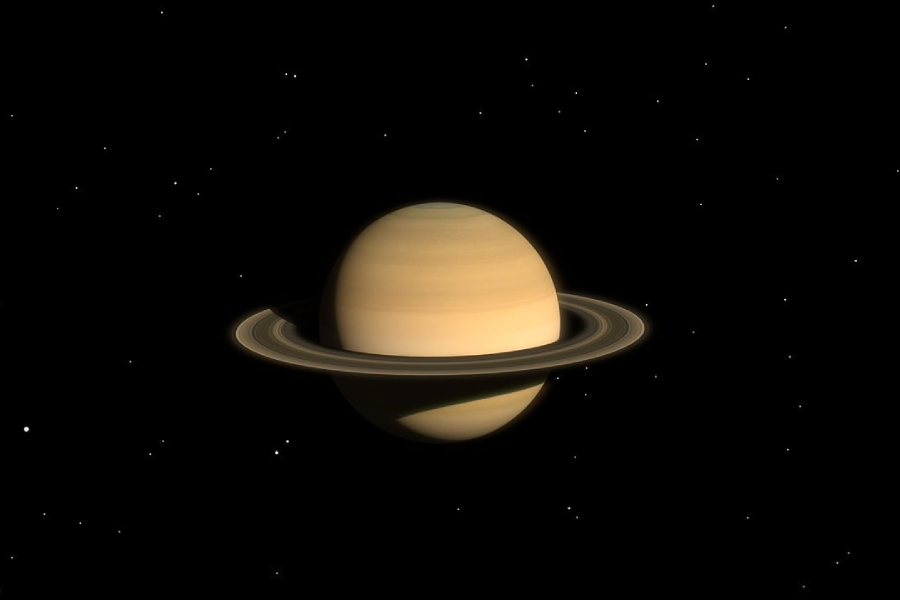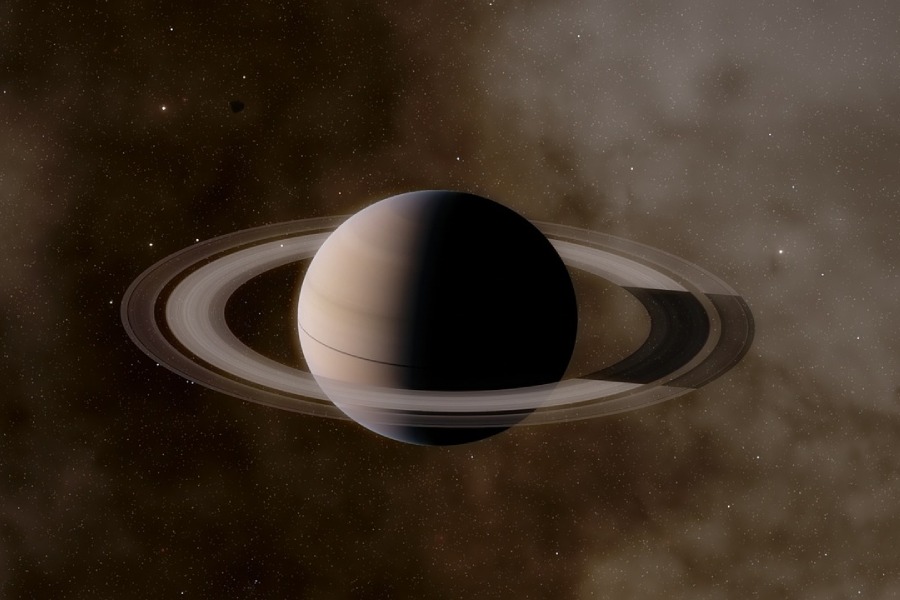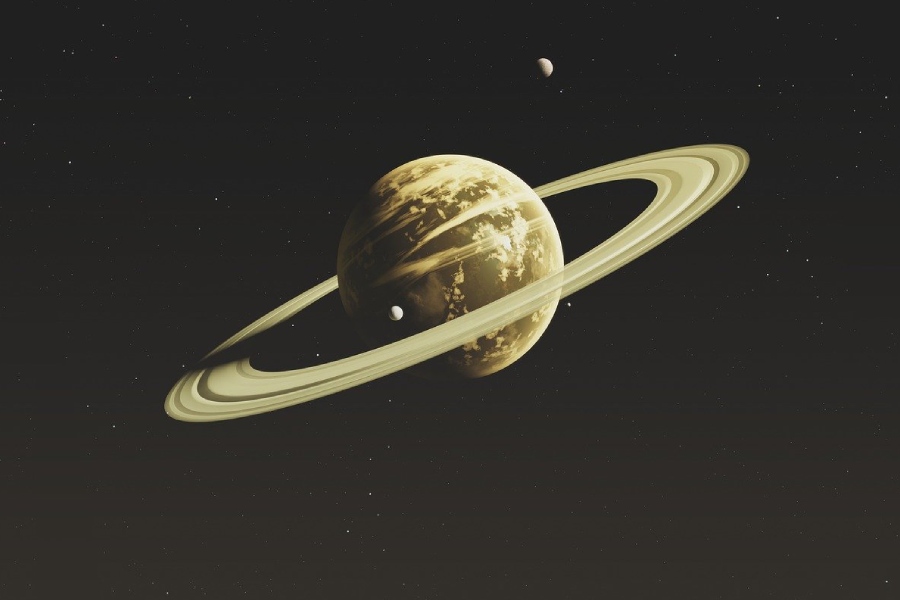With its dazzling rings and intricate cloud bands, Saturn captivates all who gaze upon it. But does this celestial gem merely tantalize the eye, or does it harbor hidden atmospheric depths waiting to be uncovered?
Saturn’s hazy stripes and spots conjure questions in the curious observer. Do they betray the presence of swirling gaseous layers, or are they merely a clever illusion?
By probing the mysteries that shroud this alien yet alluring world, we may unveil astonishing truths about the planetary atmosphere this celestial spectacle harbors or lacks entirely.
Only an exploratory plunge into Saturn’s visual splendor can reveal what secrets its filmy clouds may cloak. Do they contain swirling gasses wrapping around the planet? Or do they hide something else entirely? This pursuit promises enthralling revelations.
In this article, we examine telltale clues to investigate – does Saturn have an atmosphere at all? If so, how do interactions with its rings, moons, and the Sun shape this gaseous envelope? What forces drive the swirling Saturnian clouds? Delving into these mysteries promises astonishing revelations about Saturn’s atmospheric identity.
Does Saturn Have an Atmosphere?
Yes, Saturn does have an atmosphere. It is primarily composed of hydrogen and helium, with trace amounts of other gasses such as methane, ammonia, and water vapor.
The atmosphere of Saturn is known for its complex weather patterns, including prominent cloud bands and the famous hexagonal storm at its north pole.
Understanding the atmospheric composition serves as a foundation for the analysis of lower layers and the planetary interior. It enables the modeling of physical processes and informs estimates of Saturn’s age.

Importance of understanding Saturn’s atmospheric makeup
Saturn’s atmosphere harbors valuable clues to the planet’s origins and evolution. The ratios of gasses and isotopic traces offer insights into Saturn’s beginnings. The swirling cloud structures betray circulation patterns arising from deep within.
The detection of complex organics has provoked intrigue about potential life chemistry unfolding in Saturn’s atmosphere. Determining its precise chemical composition remains challenging, yet essential for unraveling Saturn’s secrets.
Though direct atmospheric probes are few, advanced indirect studies have gradually unveiled the potent forces that sculpt Saturn’s clouds. Over eons, atmospheric layers have danced to dynamics driven from Saturn’s underworld.
By studying the intricate bands and stripes in Saturn’s atmosphere today, we can piece together the long history carved into the face of this mysterious world.
Composition of Saturn’s Atmosphere
Breakdown of key components
Hydrogen
Hydrogen dominates Saturn’s atmosphere. It makes up most of the gas, over 90% by volume. Both molecular H2 and atomic hydrogen are present.
Their ratio indicates dynamics and gives clues into chemistry. Understanding hydrogen distribution also provides insights into models of internal structure.
Helium
Helium is the second most abundant gas after hydrogen. Its concentration, around 8%, gives clues to Saturn’s formation. The isotope ratio points to planetary origins from the solar nebula.
Helium reveals layer-mixing processes within Saturn over time. Mapping helium abundances helps constrain what drives Saturn’s atmospheric circulation.
Metallic hydrogen
Deeper below Saturn’s atmosphere, metallic hydrogen likely exists at intensely high pressures. Unlike regular molecular hydrogen, this metallic form has unique properties that may influence Saturn’s magnetic field generation. Internal heat flow is also essential for powering Saturn’s ongoing atmospheric processes and weather patterns.
If the existence of metallic hydrogen is proven, it would have major implications for improving our understanding of the extreme conditions within gas giant interiors like Saturn.
Other gases
Many other gases occur in traces but have outsized impacts, like methane, ammonia, and hydrogen sulfide, which shape albedo and cloud layers, as well as complex hydrocarbons that contribute to organic haze.
Determining minor gas abundances provides essential context. So does understanding their variation within specific cloud layers, even sparse gases, profoundly shape what we observe in Saturn’s atmospheric dynamics.
Hydrogen Gas
Hydrogen gas dominates Saturn’s atmosphere, constituting over 90% by volume. It exists in the forms of H2 molecules and H atoms, and their ratio varies across latitudes and altitudes, indicating dynamic chemical processes.
Tracking hydrogen provides valuable insights into Saturn’s formation history and ongoing weather patterns. Models must meticulously account for hydrogen distribution to accurately reflect the conditions present in Saturn’s atmosphere.
Significance of hydrogen in Saturn’s atmosphere
Hydrogen gas plays a pivotal role in determining heat flow, facilitating the movement of energy in and out of Saturn’s interior. Additionally, hydrogen chemistry shapes observed cloud layers and haze through interactions with minor gases like methane and ammonia.
The ratio of deuterium to hydrogen within Saturn offers significant clues about the origin of its hydrogen. Measurements suggest that the gas aligns with the proto-solar nebula, implying that Saturn formed early from local materials, preserving signatures since its birth.
Presence of Helium in Saturn’s Atmosphere
Helium constitutes approximately 8% of Saturn’s atmosphere, with this fraction serving as a key indicator of its origins. Models of formation and evolution strive to align with this specific value.
The percentage of helium exhibits slight variations across latitudes and different altitudes within cloud layers. Mapping this distribution provides valuable insights into mixing processes throughout Saturn’s lifetime.
Measurements of helium concentration come with uncertainties. Improved observations will refine these estimates, offering stronger constraints for atmospheric models.
Role of helium in the atmospheric composition
Helium’s role in Saturn’s atmosphere is primarily non-chemical, as it interacts minimally on a chemical level. Instead, it serves to trace bulk motions within Saturn’s atmospheric dynamics. Tracking helium complements the flow information obtained from hydrogen tracing.
The helium isotope ratio presents significant clues to its origins, with an enhancement of 3He compared to the Sun. This alignment corresponds to a formation pattern where helium sinks early into the deep interior.
Determining the abundance of atmospheric helium relative to hydrogen through depth serves as a crucial integrity check. This check is particularly important for models seeking to replicate Saturn’s layered structure.

Metallic Hydrogen
Metallic hydrogen likely exists deep within Saturn’s interior, specifically at pressures above 1 million bars and temperatures surpassing 5000 Kelvin. Under these extreme conditions, hydrogen undergoes a transition into a conductive fluid state.
If present, metallic hydrogen plays a pivotal role in influencing Saturn’s magnetic field. It has the potential to generate convective dynamo currents that sustain the planetary-scale field. Additionally, its presence can impact internal heat flow, thereby affecting atmospheric energy balances.
Confirming the existence of metallic hydrogen experimentally poses an open challenge. This is due to the inability to directly sample Saturn’s deep interior. Currently, remote sensing provides the best prospects for gathering clues about these extreme conditions far below the visible clouds.
Exotic properties and interactions
Metallic hydrogen differs profoundly from the molecular and atomic gases that make up the majority of Saturn’s atmosphere. Unlike the lighter forms, metallic hydrogen conducts electricity and heat, displaying properties similar to a liquid metal.
Beyond influencing magnetism and energy transport, metallic hydrogen may give rise to exotic alkaline compounds at intermediate depths as they interact with other infalling elements.
Predicting the behavior of these potentially complex, metastable mixtures remains challenging but is essential for accurately modeling Saturn’s internal structure.
Other Gases
While representing under 1% by volume combined, trace gasses like methane, ammonia, hydrogen sulfide, and water play an outsized role within Saturn’s cloud dynamics. They drive complex sun-fueled chemistry to generate phosphine and other compounds, shaping Saturn’s thermal structure, albedo, and hazes.
Determining the varying abundances and distribution of these minor yet impactful gasses spatially aids in modeling atmospheric circulation patterns and their linkage to Saturn’s magnetosphere. Though sparse, trace elements interact profoundly to influence what we observe in this gas giant’s stormy, layered clouds.
Roles and significance
The roles and significance of atmospheric trace gases relate to chemistry, cloud physics, and evidence of possible life. Chemical interactions of methane, hydrogen sulfide, and ammonia likely generate the elaborate cloud system visible in Saturn’s atmosphere.
These gases reveal updrafts and act as tracers through depth. Finding organics and biosignatures would revolutionize understanding of potential habitats inside gas giants. While relatively sparse compared to hydrogen and helium, the imprint of rare gases on Saturn’s atmosphere cannot be overstated. They exhibit intricate dynamics that confound predictions.
Resolving trace gas cycles will constrain models and may uncover surprises regarding the formation and ongoing evolutionary processes.
Atmospheric Circulation on Saturn
Wind and atmospheric circulation patterns
Saturn’s atmosphere exhibits a complex banded structure. Winds follow jet streams eastward and westward; cloud tracking shows speeds up to 683 m/hr. Circulation appears related to internal heat flow.
At mid-high latitudes, Saturn sustains symmetric patterns with alternating east-west jet directions. Closer to the equator, atmospheric flows mutate, showing varying strengths and more distortions over time.
This tropic-extratropic dichotomy challenges predictors as do polar cyclones, especially the hexagonal structure environing the north pole.
Insight into wind speeds and directions
Wind speeds and directions give information on forces driving flows. Cyclonic vortices indicate the conservation of angular momentum. Strong eastward equatorial jets reveal interactions between Saturn’s atmosphere and magnetic field through ion drag acceleration.
Vertical winds decay. So measurement of shear is needed to characterize three-dimensional atmospheric circulation. Layered gusts show Saturn’s atmosphere has complexity rivaling Jupiter’s.
Measuring and mapping winds across latitudes, longitudes, and over time remains an active pursuit. It guides the modeling of Saturn’s internal heat patterns and coupled dynamics between the interior, atmosphere, and magnetism.
Temperature Variations in Saturn’s Atmosphere
In Saturn’s upper troposphere, temperatures average around -274°F. But wide seasonal swings occur, especially at higher latitudes. Moving deeper, warmth increases gradually to perhaps room temperature at the water cloud base.
Further in exists a steep thermal gradient, surpassing 19,832°F likely in the metallic hydrogen layer. Mappings reveal an intricate thermal structure.
Equatorial regions tend to stay warmer than surrounding areas at similar pressure levels. This points to atmospheric drivers modulating internal heat flows across latitude and through various gas layers.
Highlighting the factors influencing temperature fluctuations
Insolation, chemical heating, and internal warmth all factor into Saturn’s atmospheric temperatures. Seasonal tilting exposes areas to more or less sunlight, causing swings of tens of degrees.
Exothermic chemical reactions also add pockets of warmth, as seen in vortex-associated temperature spikes. But much needs explaining about mechanisms stirring Saturn’s cauldron to maintain observed heat budgets.
Multiple interacting components combine to set local atmospheric temperatures on Saturn. Models aiming for accuracy must integrate forcing from varied sources.
As readings continue to find new, unexpected patterns, conveying energy up from the deep interior remains key. We have much to learn about Saturn’s restless temperature landscape over space and time.

Conclusion
Understanding factors like composition, circulation, and temperature structure in Saturn’s atmosphere remains an ongoing endeavor full of unknowns. Unraveling the tangled interactions that shape this atmosphere leads to insights into Saturn’s origins and interior conditions.
We hope this guide has enhanced appreciation for the vital role Saturn’s atmosphere plays in the planet’s evolution over cosmological timescales. So, does Saturn have an atmosphere?
Though many questions remain regarding how Saturn’s atmosphere functions, there can be no doubt whether Saturn has an atmosphere. As observations improve, so too will our comprehension of the forces stirring this gaseous envelope around Saturn.
